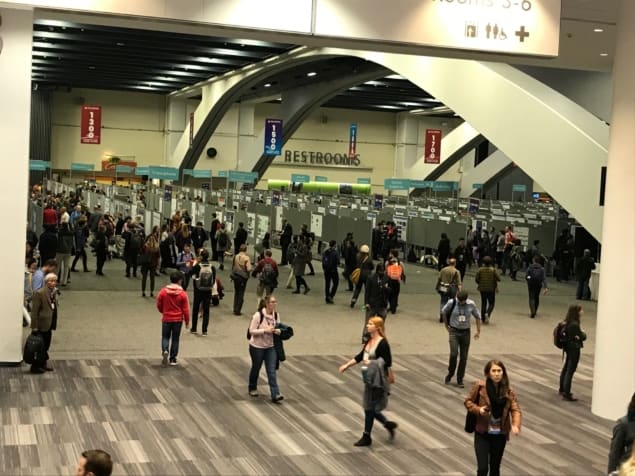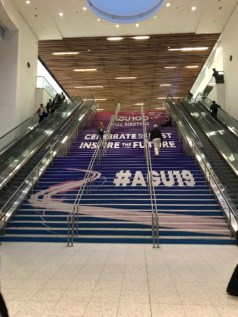
Scientific meetings evolve over time, just like plants and animals.
Take the annual Fall Meeting of the American Geophysical Union, the largest organisation of Earth and space scientists, with around 60,000 members worldwide, now wrapping up its centennial year.
I’ve attended almost every one of the AGU’s Fall Meetings since 1998, when I was appointed its first full-time public information manager, a post I held until retirement in 2007. Although changes have been gradual, this year’s meeting, which I atteneded as a freelance science writer, bears only the most basic resemblance to that in 1998.
Take the facility: the Moscone Convention Center in San Francisco, California. Back in 1998, it consisted of two buildings, North and South, connected underground, but the meeting was entirely in Moscone North. At some point, Moscone West was added to the mix, and over the years AGU has expanded into all three.

Then there’s the press room, which I ran for nine years. In my day, anywhere from 75 to 150 reporters and institutional public-information officers signed up. The reporters represented a range of daily newspapers from several countries, as well as magazines and radio networks. We provided them with 10 landline phones to send in their stories. In the press-conference room, the only equipment we needed was a 35 mm slide projector, an overhead transparancy projector, and microphones for the scientists presenting their latest discoveries.
This year’s press room offers no landline phones, as everyone has a mobile device, and stories are transmitted electronically. There are now 330 press registrants; thankfully, not all are present at any one time. But few traditional newspapers are represented. Even the San Francisco Chronicle, located a block away, which used to cover AGU with two or even three science reporters, sent no one this year. Online media, like Physics World, abound.
For press conferences, PowerPoint presentations are now preloaded, and reporters who cannot make it to the meeting can listen and watch online and even submit questions, which are put to the presenters in real time.
Do I feel nostalgic for the old days? Not really. The meeting itself is more exciting than ever. The 26,000 scientists who are attending hail from 100 countries. After the US, the greatest representation is from China. Japan, Canada, the UK, and South Korea round out the top six. They find a wide array of activities beyond the traditional oral and poster sessions of yore. There are lectures on geophysical topics in informal claimed spaces, high-tech presentations in the exhibition hall by institutions ranging from NASA to Google, workshops, town halls, tutorials and five keynote addresses.

Arctic climate continues to concern scientists
Personally, I prefer covering poster sessions, as authors are happy to discuss their research in detail, which is not possible in oral sessions. At AGU, unlike some organisations, posters are not second-class citizens.
With more than 27,000 abstracts submitted, there is simply not enough time or rooms to present all important findings orally. In fact, around two-thirds are posters, lined up in rows in a hall larger than a football pitch.
Evolution is ongoing, of course.



